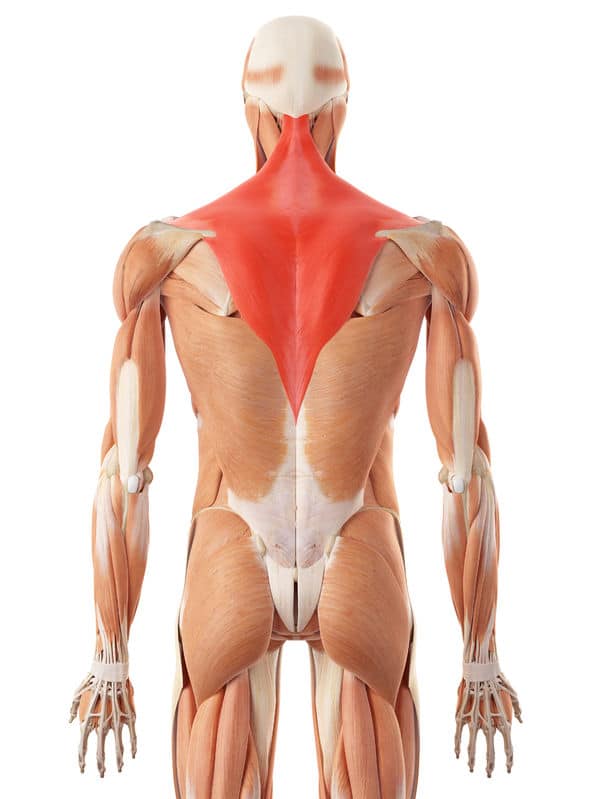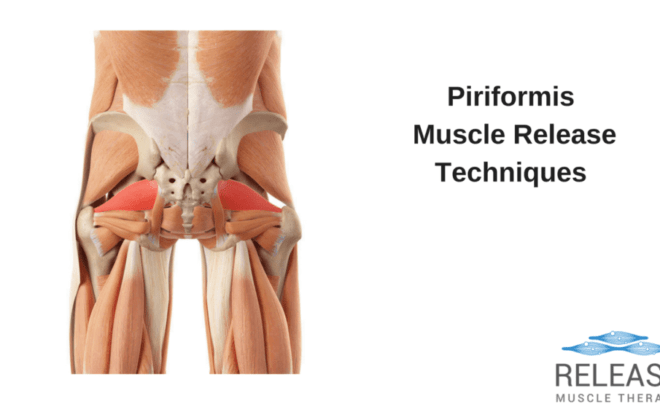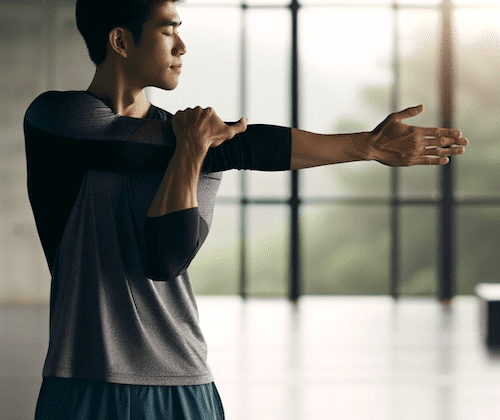Upper Trap Stretches | Top 6 Ways To Loosen Tight Trapezius Muscles
Incorporating trapezius stretches into your daily routine can work wonders for your overall well-being.
These stretches target and loosen the trapezius muscle, an essential muscle responsible for stabilizing your arm, rotating your shoulder blade, and extending your neck.
By releasing the tension and stress built up in the trapezius muscle, it opens up room for improvement in your posture, reduced pain and discomfort, and enhanced mobility.
Trapezius stretches are especially beneficial for those who spend long hours in a sedentary position, as they help to counteract the negative effects of sitting for extended periods.
But where do you start with trapezius stretches?
In this article, we’ll delve into the anatomy and function of your trapezius muscle, explore the leading causes of tightness and pain, and provide you with expert-recommended stretching techniques to incorporate into your routine.
Ready to learn? Let’s get started!
Trapezius Muscles Anatomy And Function

Understanding the anatomy and function of your trapezius muscles is key to properly caring for and stretching these muscles. Let’s take a look at what they entail.
Trapezius muscles are large, triangular-shaped muscles located in the upper back, extending from the base of the skull down to the mid-back and laterally to the shoulders.
These muscles are essential for proper shoulder and neck movements, as well as maintaining posture and overall upper-body strength.
The trapezius muscles can be divided into three distinct sections, each with its own set of functions:
- The upper trapezius is responsible for elevating the shoulders and rotating the shoulder blade outward.
- The middle trapezius helps to retract or pull the shoulder blades together and provide stability to the shoulder joint.
- The lower trapezius assists in the depression of the shoulder blade and extension of the neck.
- Raise our arms above our heads when stretching
- Throw overarm
When the trapezius muscles are functioning properly, they help to maintain a healthy and strong upper body, but when they become tight or strained, they can lead to pain and discomfort in the shoulders, neck, and upper back.
But what exactly causes the tightness in the upper trapezius? Let’s have a look in the next section.
Causes Of Upper Trapezius Tightness
The trapezius muscles are very responsive to fatigue of underlying muscles, in particular the scalenes and the levator scapula. These underlying muscles are often in disadvantaged positions due to rounded shoulders and an excessively forward-positioned head.
The upper trapezius muscles, in addition to being compensators for this position, can be de-conditioned and weak as well. Don’t fall into the trap of only stretching and massaging these muscles. Building up strength and endurance is part of a proper strategy for restoring optimal muscle function.
Let’s take a look at specific causes of upper trapezius tightness.
- Poor posture: Sitting or standing with poor posture can cause tension and tightness in the trapezius muscle as well as pain in levator scapulae. This is often seen in people who work at a desk or computer for long periods of time.
- Repetitive motion: Repeating the same motion, such as lifting heavy objects or using a computer mouse, can cause overuse and strain on the trapezius muscle.
- Stress: Emotional stress can cause tension in the trapezius muscle, leading to pain and discomfort.
- Injury: Trauma to the neck or shoulders, such as whiplash or a fall, can cause tightness and pain in the trapezius muscle.
- Sleeping position: Sleeping in an uncomfortable position or on a pillow that is too high or too low can cause tension and tightness in the trapezius muscle.
- Lack of exercise: A sedentary lifestyle and lack of exercise can lead to weak muscles, including the trapezius, which can cause pain and tightness.
- Medical conditions: Certain medical conditions, such as fibromyalgia and myofascial pain syndrome, can cause chronic pain and tightness in the trapezius muscle.
Upper Trap Stretches
Stretching the upper trapezius is fairly straightforward when you know the function of the muscle. There are some additional ways to encourage the traps to relax, such as using a massage percussion gun, or tools such as a Theracane.
Let’s look at the fundamental upper trapezius stretches recommended for you.
#1. Shoulder Rolls
Shoulder rolls should be done at the beginning of every upper trap stretch. You need to undertake them before exercises so that they warm up and loose the muscles before you start full-on stretches.
- Sit or stand in a comfortable position with good posture
- Roll both shoulders back and down and then forwards and up in a circular motion
- Start with small circles and gradually make the circles larger
- Spend 30-60 seconds doing this and then repeat in the opposite direction
#2. Chin Tucks
Chin tucks are done to realign the neck and ease the tension off the upper traps, combat a forward poking chin posture, and loosen joints in the lower neck and upper back. They’re better done in front of a mirror or with expert guidance to ensure you do them correctly. Additionally, you also need to ensure that you’re relaxed and take breaks from time to time.
To be effective, here is what you need to do:
- Sit or stand upright in good posture
- Slowly draw your chin in towards your neck without tilting your head
- To ensure the correct technique, imagine your chin is sitting on a shelf and you are sliding your chin in along the shelf – it should feel like you are giving yourself a double chin
- Hold for 3 seconds and relax. Repeat 10-15 times
#3. Upper Trap Side Bends
Doing side bends will help you loosen tight trapezius muscles. When doing the stretch, ensure you tilt your head gently because it can cause general discomfort.
Here is the correct procedure.
- Sit upright in a chair ensuring good posture
- Place one of your arms behind your back and keep it there throughout the exercise.
- Tilt your head to one side, taking your ear down towards your shoulder
- Keep your eyes and nose pointed forwards through
- Hold for 3 seconds and return to starting position
- Repeat to the other side, aiming for 10-15 reps each way
#4. Upper Trap Head Tilts
After side bends, immediately follow them with head tilts. They should be done slowly but steadily to ensure your trapezius muscles cope well.
Here is the recommended procedure:
- Sit upright in a chair, ensure good posture, and hold the bottom of the chair with one hand
- Place your free hand over the side of your head (towards the back) and gently pull your head further over for a stronger stretch
- Once your head is tilted over to the side, turn your head to look down towards your hip – you should feel the traps stretch further back
- Tilt your head to the opposite side, taking your ear towards your shoulder
- Anchoring your shoulder down by holding the bottom of the chair helps increase the trapezius stretches.
#5. Middle Trapezius Stretch
This stretch allows you to stretch both sides of the trapezius muscles at the same time.
Procedure
- Sit or stand ensuring good posture
- Place your hands and forearms together. Interlace your fingers and draw your hands forward until you feel a stretch across your upper back.
- Draw your shoulders and shoulder blades forward until you feel a stretch along your upper back
- Increase the stretch further by bringing your chin down towards your chest
- Hold for 15-30 seconds and repeat 3-5 times.
#6. Sideways Child’s Pose
This pose allows you to stretch your trapezius muscles and upper back at the same time.
Procedure
- Kneel on all fours, hands under shoulders, knees under feet
- Slowly sit your buttocks back onto your feet, letting your chest come down to the floor
- Holding the position, gradually slide/walk your hands out to the side to stretch out your tight trapezius muscle
- Hold for 30 seconds, then take your hands over to the other side and repeat
- Return to starting position and then repeat 2-3 times each way
Remember to breathe deeply and relax into each stretch. Hold each stretch for 10-15 seconds and repeat as needed throughout the day. With consistent stretching, you can help to reduce tension and pain in your trapezius muscles.
Massage For Upper Trapezius Pain Relief
The traps are often a strong focus area for massage therapy, and these muscles are very easy to access. Self massage is another option and is easy to perform.
Massage Ball Stretches
Massage ball stretches help you trigger trapezius points or knots by using a tennis ball placed over your back.
Procedure.
- Stand with your back towards the wall and place the ball behind your back over the trapezius knot/tight area
- Lean back into the ball to apply gentle pressure to stretch the trapezius
- For a knotted trapezius muscle hold the pressure for 30-60 seconds, for a chronically tight trapezius roll the ball in small movements (up/down, side/side or circles) for 1-2 minutes
Loosen up those tense upper trapezius muscles with these four easy stretches:
- The first stretch involves lying on your stomach and using a ball to gently massage around the base of your skull and the side of your neck.
- The second stretch is done by placing a ball underneath your upper traps and pushing gently into the knot, or rolling the ball around for a general stretch.
- For a super tight trapezius muscle, the third stretch can be done by lying on the floor in an open doorway and placing the ball between the wall and the muscle.
- Lastly, stand by an open doorway for the fourth stretch, bend at the waist, place a ball on the top part of your trapezius, and lean into the ball to stretch out those upper trapezius muscles.
FAQ:
How long does it take for trapezius pain to go away?
The duration it takes for trapezius pain to go away depends on several factors, including the cause of the pain, the severity of the injury, and the type of treatment received. For minor muscle strains or overuse injuries, trapezius pain may resolve in a few days with rest and self-care measures such as stretching and icing. However, for more severe injuries or conditions such as herniated discs or nerve impingements, pain relief may take several weeks to months. It is crucial to seek medical attention for persistent or worsening trapezius pain to determine the underlying cause and receive appropriate treatment.
Can you massage trap pain out?
Yes, massage can be an effective way to alleviate trapezius pain. Massaging the affected area can help to increase blood flow and promote healing by reducing tension and relaxing the muscles. However, it’s important to note that massage may not work for everyone, and the effectiveness of massage for trapezius pain relief can depend on the underlying cause of the pain. For best results, it’s recommended to consult a healthcare professional or a licensed massage therapist who can provide personalized guidance and treatment.
What is the best sleeping position for trapezius pain?
The best sleeping position for trapezius pain is on your back with a small pillow or rolled-up towel under your neck to support the natural curve of your spine. This position helps to prevent your head and neck from twisting, which can exacerbate trapezius pain. If sleeping on your back is uncomfortable, you can try sleeping on your side with a pillow between your knees to help align your spine and relieve pressure on your shoulders. It’s important to avoid sleeping on your stomach if your traps are flared up as this can strain your neck and shoulders, leading to further trapezius pain.
What are trigger points in the trapezius?
Trigger points in the trapezius muscle are knots or tight areas that form in the muscle fibers, causing pain and discomfort. These points can be sensitive to touch and can cause referred pain in other areas of the body. Trigger points in the trapezius can develop due to poor posture, repetitive strain, overuse of the muscle, stress, or injury. Common symptoms of trigger points in the trapezius muscle include headaches, neck pain, shoulder pain, and limited range of motion. Trigger point therapy, which involves applying pressure to the affected area, can help alleviate pain and discomfort caused by trigger points in the trapezius muscle.
How do you loosen your upper traps?
- Stretching: Perform gentle stretches that target the trapezius muscle, such as the ear-to-shoulder stretch or the chin-to-chest stretch.
- Self-massage: Use a foam roller or a massage ball to apply pressure to the upper traps and release tension.
- Heat therapy: Apply a heat pad or take a warm shower to relax the muscles and increase blood flow to the upper traps.
- Posture correction: Practice good posture by keeping your shoulders back and down and avoiding slouching.
- Ergonomic adjustments: Adjust your workspace or daily activities to minimize strain on the upper traps. For example, use a headset during phone calls to avoid cradling the phone between your ear and shoulder.
What causes tight upper traps?
There are several factors that can contribute to tightness in the upper trapezius muscles, including:
- Poor posture: Maintaining poor posture for prolonged periods can cause the upper trapezius muscles to overwork and become tense and tight.
- Stress and tension: Emotional and mental stress can lead to muscle tension, including in the upper trapezius muscles.
- Repetitive strain: Activities that require repetitive motion of the arms, neck, or shoulders can cause strain on the upper trapezius muscles and lead to tightness.
- Injury: Trauma or injury to the upper back or neck can cause the upper trapezius muscles to tighten as a protective response.
- Sleeping position: Sleeping in an awkward position that strains the neck or shoulders can cause the upper trapezius muscles to become tight and painful.
- Weakness in other muscles: Weakness in the muscles (such as the pec minor) that support the upper back and neck can cause the upper trapezius muscles to overcompensate and become tight.
How do you stretch your right upper trap?
- Shoulder Rolls: Roll your shoulders in a circular motion, lifting them up to your ears and then rolling them back and down. Repeat this motion several times, and then reverse the direction of the rolls.
- Neck Stretch: Tilt your head to the left, bringing your ear towards your left shoulder. Use your left hand to gently pull your head further to the left to intensify the stretch. Hold for 20-30 seconds and then repeat on the other side.
- Ball Roll: Lie on your back and place a massage ball or tennis ball underneath your right upper trapezius muscle. Move your body so that the ball rolls over the muscle, applying pressure to tight or sore spots.
- Doorway Stretch: Stand in a doorway with your right arm extended to the side, resting on the doorframe. Lean your body forward, keeping your arm in place, until you feel a stretch in your right upper trapezius muscle. Hold for 20-30 seconds and then repeat on the other side.
- Upper Trap Stretch: Sit or stand up straight and gently tilt your head to the right, bringing your ear towards your right shoulder. Use your right hand to gently pull your head further to the right to intensify the stretch. Hold for 20-30 seconds and then repeat on the other side.
Sam Visnic
Most Popular Posts
Categories
- Deep Gluteal Pain Syndrome (8)
- Deltoids (2)
- Foam Rolling (2)
- Glutes (9)
- Hamstrings (5)
- Hypnosis for Pain (3)
- Lats (2)
- Levator Scapulae (4)
- Lifestyle (8)
- Massage Therapy (39)
- Mobility (21)
- Movement and Exercise (19)
- Muscles (22)
- Nutrition (2)
- Obliques (1)
- Pain (25)
- Pectorals (3)
- Piriformis (3)
- Plantar Fasciitis (11)
- Psoas (11)
- Quadratus Lumborum (3)
- Quadriceps (2)
- Rhomboids (3)
- Sciatica (1)
- Serratus Anterior (1)
- SI Joint (14)
- Sternocleidomastoid (1)
- Stretching (18)
- Subscapularis (1)
- TMJ (2)
- Trapezius (1)
- Uncategorized (12)









